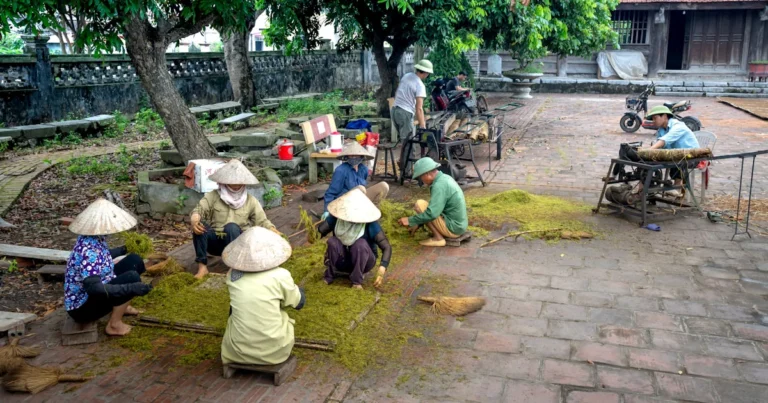Support our educational content for free when you purchase through links on our site. Learn more
Have you ever wandered through a neighborhood and stumbled upon a vibrant garden, buzzing with life and laughter? Community gardens are more than just patches of green; they are thriving ecosystems that foster connections, promote sustainability, and provide fresh produce to local residents. In this article, we’ll explore seven distinct types of community gardens that cater to various needs and interests, from neighborhood gardens that cultivate community spirit to therapy gardens that promote healing through nature.
Did you know that community gardens can significantly improve mental health and well-being? Studies show that spending time in green spaces can reduce stress and anxiety, making these gardens vital for urban communities. So, whether you’re looking to start your own garden or simply want to get involved, this guide will equip you with the knowledge you need to dig in and grow together!
Key Takeaways
- Diverse Types: Explore seven unique types of community gardens, each serving different purposes and communities.
- Community Benefits: Community gardens foster social connections, improve food security, and enhance mental well-being.
- Getting Started: Learn how to start your own community garden with practical steps and tips.
- Inspiring Success Stories: Discover real-life examples of community gardens making a difference in neighborhoods.
- 👉 Shop Gardening Resources: Check out essential gardening tools and books to kickstart your gardening journey:
- Gardening Tools: Amazon | Walmart | Home Depot
- Books on Community Gardening: The Edible Schoolyard | The Garden Primer
Table of Contents
- Quick Tips and Facts
- The Evolution of Community Gardens: A Historical Perspective
- Exploring the Various Types of Community Gardens
- 1. Neighborhood Gardens: Cultivating Community Spirit
- 2. School Gardens: Learning Through Gardening
- 3. Allotment Gardens: Personal Plots in Shared Spaces
- 4. Donation Gardens: Giving Back to the Community
- 5. Therapy Gardens: Healing Through Nature
- 6. Market Gardens: Growing for Profit
- 7. Urban Farms: A Sustainable Approach to City Living
- The Benefits of Community Gardening: More Than Just Vegetables
- How to Start Your Own Community Garden
- Success Stories: Inspiring Community Garden Projects
- Challenges in Community Gardening: What to Watch Out For
- Connect with Us: Join the Community Gardening Movement
- Conclusion
- Recommended Links
- FAQ
- Reference Links
Quick Tips and Facts #quick-tips-and-facts
🌱 Did you know? Community gardens offer a plethora of benefits, from fostering a sense of belonging to increasing access to fresh, healthy food. They can be as diverse as the communities they serve, catering to different needs and interests.
🧑🌾 Here at Community Gardening™, we believe everyone should have the opportunity to experience the joy of gardening. That’s why we’re passionate about supporting community gardens and helping them thrive.
💡 Ready to dig in? Here are a few quick tips to get you started:
- Start small: Don’t feel pressured to create a massive garden right away. Begin with a few raised beds or a small plot of land. You can always expand later!
- Build a strong team: Gardening is more fun with friends! Assemble a group of passionate individuals who can share the workload and offer support.
- Engage your community: Reach out to local businesses, organizations, and residents to garner support and resources for your garden.
- Celebrate your successes: Take the time to acknowledge milestones and appreciate the hard work of your volunteers. A little celebration goes a long way!
The Evolution of Community Gardens: A Historical Perspective #the-evolution-of-community-gardens-a-historical-perspective
Community gardens, far from being a modern trend, have deep roots in our history. Let’s take a trip down memory lane and explore their fascinating evolution:
Ancient Origins: From Necessity to Social Hubs
The concept of communal gardening can be traced back to ancient civilizations. In Mesopotamia, Egypt, and the Indus Valley, shared gardens provided sustenance and fostered social interaction. These early gardens were often integrated into the fabric of daily life, serving as gathering places for celebrations, rituals, and the exchange of knowledge.
The Rise of Allotment Gardens: A Response to Urbanization
Fast forward to the 19th century, the Industrial Revolution sparked rapid urbanization, leading to crowded living conditions and limited access to green spaces. In response to these challenges, the allotment garden movement gained momentum in Europe. These gardens, typically divided into individual plots, provided urban dwellers with a space to grow their own food and find respite from the hustle and bustle of city life.
Victory Gardens: A Symbol of Resilience
During times of war and economic hardship, community gardens have played a vital role in ensuring food security and boosting morale. During World War I and II, “Victory Gardens” sprouted up in backyards, vacant lots, and even rooftops across Europe and North America. These gardens not only supplemented food rations but also fostered a sense of community and national unity.
The Modern Community Garden Movement: A Tapestry of Purposes
Today, community gardens continue to flourish, driven by a renewed interest in sustainability, local food systems, and community building. Modern community gardens are incredibly diverse, encompassing everything from neighborhood gardens focused on sharing the harvest to school gardens that educate children about the wonders of nature.
10 Creative Ways to Encourage and Influence Others to Love Gardening 🌱
Exploring the Various Types of Community Gardens #exploring-the-various-types-of-community-gardens
Just like there’s no one-size-fits-all approach to gardening, there’s a diverse array of community garden models, each with its own unique characteristics and objectives. Let’s delve into the wonderful world of community gardens and explore the different types you might encounter:
1. Neighborhood Gardens: Cultivating Community Spirit #1-neighborhood-gardens-cultivating-community-spirit
Imagine a sunny afternoon, strolling through your neighborhood, and stumbling upon a vibrant garden bustling with activity. Laughter fills the air as neighbors exchange gardening tips, children chase butterflies, and the aroma of freshly harvested herbs wafts through the breeze. This, my friends, is the essence of a neighborhood garden!
Key Features:
- Shared Ownership: Plots are typically assigned to individual households, but the entire garden is managed collectively.
- Community Building: These gardens are all about fostering connections, encouraging collaboration, and creating a sense of belonging.
- Diverse Harvests: From tomatoes and zucchini to sunflowers and strawberries, neighborhood gardens showcase a delightful variety of plants.
Benefits:
- Strengthened Community Bonds: Gardening side-by-side provides a natural platform for neighbors to connect, share stories, and build lasting friendships.
- Increased Access to Fresh Food: Imagine stepping out your door and picking fresh lettuce for your salad! Neighborhood gardens make healthy eating convenient and enjoyable.
- Enhanced Neighborhood Aesthetics: A well-maintained community garden can transform a vacant lot into a vibrant green space, boosting curb appeal and community pride.
2. School Gardens: Learning Through Gardening #2-school-gardens-learning-through-gardening
Remember the excitement of discovering a ladybug on a leaf or the satisfaction of watching a tiny seed sprout into a plant? School gardens provide children with these magical experiences, transforming traditional classrooms into hands-on learning environments.
Key Features:
- Educational Focus: These gardens are designed to complement classroom curricula, bringing lessons to life through hands-on activities.
- Interdisciplinary Learning: Gardening integrates various subjects, including science, math, art, and social studies.
- Student Engagement: Children are empowered to take ownership of their learning as they plant, nurture, and harvest their own food.
Benefits:
- Improved Academic Performance: Studies have shown that school gardens can enhance students’ academic performance, particularly in science and math.
- Increased Interest in Healthy Eating: When children grow their own food, they’re more likely to develop a taste for fruits and vegetables.
- Environmental Stewardship: School gardens instill a love for nature and teach children about the importance of sustainability.
3. Allotment Gardens: Personal Plots in Shared Spaces #3-allotment-gardens-personal-plots-in-shared-spaces
For those seeking a bit more independence in their gardening endeavors, allotment gardens offer the perfect balance of personal space and communal spirit. Imagine rows of meticulously tended plots, each reflecting the unique personality of its gardener, all nestled within a larger shared space.
Key Features:
- Individual Plots: Gardeners rent or lease their own plots, giving them the freedom to choose what they want to grow and how they want to manage their space.
- Shared Resources: While plots are individually managed, allotment gardens often have shared resources, such as water access, tools, and composting facilities.
- Sense of Community: Even with individual plots, allotment gardens foster a sense of community through shared workdays, social events, and the exchange of gardening wisdom.
Benefits:
- Increased Food Security: Allotment gardens provide individuals and families with a reliable source of fresh, homegrown produce.
- Physical Activity and Stress Relief: Gardening is a great way to get exercise, enjoy the outdoors, and de-stress from the demands of daily life.
- Skill Development: Allotment gardens offer a supportive environment for gardeners of all levels to learn new skills and experiment with different gardening techniques.
4. Donation Gardens: Giving Back to the Community #4-donation-gardens-giving-back-to-the-community
Imagine a garden where every seed sown, every weed pulled, and every tomato harvested is a testament to the power of compassion and community. Welcome to the world of donation gardens, where the fruits of labor nourish both body and soul.
Key Features:
- Charitable Mission: The primary purpose of donation gardens is to provide fresh produce to those in need, such as food banks, shelters, or community kitchens.
- Collaborative Spirit: These gardens thrive on the dedication of volunteers who generously donate their time and effort to make a difference.
- Focus on Productivity: Donation gardens often prioritize high-yield crops and efficient gardening practices to maximize the amount of food they can donate.
Benefits:
- Combating Food Insecurity: Donation gardens play a vital role in addressing food insecurity by providing nutritious produce to those who might not otherwise have access to it.
- Promoting Community Engagement: These gardens bring people together from all walks of life, fostering a sense of unity and shared purpose.
- Supporting Healthy Lifestyles: By providing access to fresh fruits and vegetables, donation gardens contribute to the health and well-being of the community.
5. Therapy Gardens: Healing Through Nature #5-therapy-gardens-healing-through-nature
There’s something inherently therapeutic about digging in the soil, nurturing plants, and witnessing the beauty of nature unfold. Therapy gardens harness this innate power of nature to promote healing, well-being, and personal growth.
Key Features:
- Accessible Design: Therapy gardens are designed to be accessible to people of all abilities, featuring raised beds, wide pathways, and sensory-rich elements.
- Therapeutic Goals: These gardens are often integrated into healthcare settings, rehabilitation centers, or community organizations to support specific therapeutic goals, such as reducing stress, improving motor skills, or fostering social interaction.
- Trained Professionals: Therapy gardens are often facilitated by trained professionals, such as horticultural therapists or occupational therapists, who guide participants in meaningful gardening activities.
Benefits:
- Reduced Stress and Anxiety: Studies have shown that spending time in nature can lower stress hormones, reduce anxiety, and improve mood.
- Improved Physical Function: Gardening activities can enhance motor skills, balance, and coordination.
- Increased Socialization and Communication: Therapy gardens provide a welcoming and supportive environment for individuals to connect with others and build relationships.
6. Market Gardens: Growing for Profit #6-market-gardens-growing-for-profit
Imagine a bustling farmers’ market, filled with colorful displays of fresh, locally grown produce. Behind those vibrant stalls often lie the hard work and dedication of market gardeners, who turn their passion for growing into thriving businesses.
Key Features:
- Business Orientation: Market gardens are driven by the goal of producing and selling high-quality produce for profit.
- Efficient Production: These gardens often employ intensive growing techniques, such as crop rotation, companion planting, and season extension methods, to maximize yield and profitability.
- Direct-to-Consumer Sales: Market gardeners often sell their produce directly to consumers through farmers’ markets, community-supported agriculture (CSA) programs, or roadside stands.
Benefits:
- Supporting Local Economies: Market gardens contribute to the local economy by creating jobs, supporting small businesses, and keeping money within the community.
- Promoting Sustainable Agriculture: By focusing on local production and distribution, market gardens reduce the environmental impact associated with long-distance food transportation.
- Providing Fresh, Flavorful Food: Market gardens offer consumers access to the freshest, most flavorful produce, often harvested at the peak of ripeness.
7. Urban Farms: A Sustainable Approach to City Living #7-urban-farms-a-sustainable-approach-to-city-living
Who says you need sprawling fields and rustic barns to experience the joys of farming? Urban farms are transforming concrete jungles into oases of green, bringing fresh food and a touch of the countryside to the heart of the city.
Key Features:
- Urban Setting: As the name suggests, urban farms are located within cities, utilizing vacant lots, rooftops, or even vertical spaces to grow food.
- Sustainability Focus: These farms often prioritize sustainable practices, such as water conservation, composting, and renewable energy, to minimize their environmental impact.
- Community Engagement: Urban farms often serve as educational hubs, offering workshops, volunteer opportunities, and events that connect city dwellers with the source of their food.
Benefits:
- Increased Food Access: Urban farms bring fresh, healthy food to underserved communities, reducing food deserts and promoting healthy eating habits.
- Environmental Regeneration: By transforming underutilized spaces into productive gardens, urban farms help mitigate the urban heat island effect, improve air quality, and create green spaces for wildlife.
- Economic Opportunities: Urban farms can create jobs, support local businesses, and revitalize neighborhoods.
The Benefits of Community Gardening: More Than Just Vegetables #the-benefits-of-community-gardening-more-than-just-vegetables
Community gardens are like the gift that keeps on giving, offering a wealth of benefits that extend far beyond the garden gate. Let’s dig into the bountiful harvest of positive impacts these green spaces bring to individuals, communities, and the environment:
- Fostering Social Connections: Remember that feeling of camaraderie when you and your neighbors gathered for a common goal? Community gardens act as vibrant social hubs, connecting people from diverse backgrounds, fostering friendships, and strengthening community bonds.
- Promoting Health and Well-being: Did you know that gardening is a great form of exercise? It’s true! Community gardens encourage physical activity, reduce stress, and provide a welcome dose of Vitamin D. Plus, access to fresh, homegrown produce promotes healthy eating habits.
- Enhancing Food Security: For many, community gardens provide a vital source of fresh, nutritious food, particularly in underserved communities where access to affordable, healthy options may be limited.
- Empowering Education: From teaching children about the life cycle of plants to providing hands-on learning opportunities for adults, community gardens serve as living classrooms, fostering environmental stewardship and a deeper understanding of where our food comes from.
- Beautifying Neighborhoods: Let’s face it, a well-tended garden can work wonders for a neighborhood’s aesthetic appeal! Community gardens transform vacant lots into vibrant green spaces, increasing property values, reducing crime, and fostering a sense of pride in the community.
- Supporting Sustainability: By growing food locally, community gardens reduce our reliance on industrial agriculture, decrease transportation emissions, and promote biodiversity.
How to Start Your Own Community Garden #how-to-start-your-own-community-garden
Inspired to cultivate a community garden in your own neighborhood? We’re here to help you navigate the process, step by step:
1. Gather Your Gardening Gang:
- Every successful garden needs a dedicated team! Reach out to neighbors, friends, and local organizations to find like-minded individuals who share your passion for gardening and community building.
2. Scout the Perfect Spot:
- Location is key! Look for a sunny spot with good drainage that’s easily accessible to the community. Consider factors like proximity to water sources, existing infrastructure, and potential environmental hazards.
3. Secure the Green Light:
- Once you’ve found a promising location, you’ll need to obtain permission from the landowner, whether it’s the city, a local business, or a private individual.
4. Develop a Solid Plan:
- A well-structured plan is essential for a thriving garden. Consider factors like garden design, plot allocation, water access, tool storage, composting methods, and community involvement.
5. Spread the Word and Recruit Gardeners:
- Host community meetings, distribute flyers, and leverage social media to generate excitement and recruit enthusiastic gardeners.
6. Get Your Hands Dirty:
- It’s time to put those gardening gloves on! Organize community workdays to prepare the soil, build raised beds, install irrigation systems, and plant your first crops.
7. Nurture Your Garden and Your Community:
- Gardening is an ongoing journey of learning, adapting, and celebrating successes. Establish clear communication channels, organize regular workdays, and host social events to foster a strong sense of community.
Success Stories: Inspiring Community Garden Projects #success-stories-inspiring-community-garden-projects
Across the globe, community gardens are blossoming into beacons of hope, transforming neighborhoods and enriching lives. Let’s take a look at some inspiring success stories that showcase the transformative power of these green spaces:
- The Edible Schoolyard Project: Founded by renowned chef Alice Waters, this groundbreaking initiative has established organic gardens and kitchen classrooms in hundreds of schools across the United States, transforming the way children eat, learn, and connect with nature.
- The Ron Finley Project: Dubbed the “Gangster Gardener,” Ron Finley has transformed food deserts in South Central Los Angeles by planting vibrant gardens in neglected public spaces, empowering residents to take control of their food sources and improve their health.
- The Urban Harvest Program: This Houston-based organization supports over 160 community gardens, providing resources, education, and a platform for community members to connect, grow their own food, and access fresh, healthy produce.
Challenges in Community Gardening: What to Watch Out For #challenges-in-community-gardening-what-to-watch-out-for
While community gardens offer a plethora of benefits, it’s important to acknowledge the challenges that can arise along the way. By anticipating these hurdles, we can develop strategies to overcome them and ensure the long-term success of our gardens:
- Funding and Resources: Securing adequate funding for tools, supplies, water access, and infrastructure can be an ongoing challenge. Explore creative fundraising options, seek grants, and build partnerships with local businesses and organizations.
- Volunteer Management: Community gardens rely heavily on the dedication of volunteers. Establish clear roles and responsibilities, provide adequate training, and foster a welcoming and appreciative environment to keep volunteers engaged.
- Conflict Resolution: Disagreements among gardeners can arise, particularly in shared spaces. Establish clear communication channels, develop a conflict resolution process, and encourage open dialogue to address issues constructively.
- Pests, Diseases, and Weeds: Just like any garden, community gardens are susceptible to pests, diseases, and weeds. Implement integrated pest management strategies, practice crop rotation, and encourage good sanitation practices to minimize these challenges.
- Access and Equity: Ensure that your community garden is accessible to people of all abilities, incomes, and backgrounds. Consider factors like transportation, language barriers, and cultural sensitivities to create a welcoming and inclusive space.
Connect with Us: Join the Community Gardening Movement #connect-with-us-join-the-community-gardening-movement
Ready to dig into the world of community gardening? We’re here to help you every step of the way! Connect with us to:
- Find a Community Garden Near You: Join our vibrant network of gardeners and discover a community garden in your neighborhood.
- Access Resources and Support: From gardening tips and grant opportunities to educational materials and volunteer training, we’re here to support your community gardening endeavors.
- Share Your Story: We believe that every community garden has a unique story to tell. Share your experiences, challenges, and triumphs with us!
Let’s grow together! 🌱
Conclusion

In this deep dive into the types of community gardens, we’ve explored the vibrant tapestry of green spaces that enrich our neighborhoods and foster connections among diverse individuals. From neighborhood gardens that cultivate community spirit to therapy gardens that promote healing, each type serves a unique purpose and offers a wealth of benefits.
Key Takeaways:
- Community gardens are not just about growing food; they are about growing relationships, knowledge, and a sense of belonging.
- Each type of garden has its own unique features and benefits, catering to various community needs and interests.
- Starting a community garden can be a rewarding experience, bringing people together and creating lasting impacts.
So, whether you’re inspired to start your own garden or simply want to get involved in your local community, remember that every seed planted is a step towards a more connected and sustainable future. 🌍✨
Recommended Links
👉 Shop Gardening Resources:
- Gardening Tools: Amazon | Walmart | Home Depot
- Books on Community Gardening:
FAQ

What are the benefits of participating in a community garden?
Participating in a community garden offers numerous benefits:
H4: Social Connections
Community gardens foster friendships and connections among neighbors, creating a sense of belonging and community spirit.
H4: Access to Fresh Produce
Gardening provides access to fresh, healthy fruits and vegetables, promoting better nutrition and healthier eating habits.
H4: Physical and Mental Health
Gardening is a great form of exercise, helping to reduce stress and improve overall well-being. Spending time in nature has been shown to enhance mood and mental health.
H4: Educational Opportunities
Community gardens serve as living classrooms, teaching individuals of all ages about gardening, sustainability, and healthy living.
Read more about “How Can We Keep Community Gardens Sustainable? 10 Essential Practices to Thrive! 🌱”
How do I start a community garden in my neighborhood?
Starting a community garden involves several key steps:
H4: Gather Support
Assemble a group of interested individuals who share your passion for gardening and community building.
H4: Find a Suitable Location
Look for a sunny, accessible spot with good soil and water access. Secure permission from the landowner.
H4: Create a Plan
Develop a clear plan outlining the garden’s design, management structure, and community involvement.
H4: Engage the Community
Promote the garden through meetings, flyers, and social media to recruit participants and volunteers.
Read more about “How Does a Community Garden Impact the Community? 10 Surprising Benefits 🌱 …”
What are some common types of community gardens, such as allotment gardens or rooftop gardens?
Common types of community gardens include:
H4: Neighborhood Gardens
Shared spaces where neighbors grow food together, fostering community spirit.
H4: Allotment Gardens
Individual plots rented out to gardeners, allowing for personal gardening while still being part of a community.
H4: School Gardens
Educational gardens integrated into school curricula, teaching children about food, health, and the environment.
H4: Rooftop Gardens
Utilizing urban rooftops for gardening, these spaces maximize limited land and provide fresh produce in city environments.
How can community gardens help build stronger, more sustainable local communities?
Community gardens play a vital role in building stronger, sustainable communities:
H4: Food Security
By providing access to fresh produce, community gardens help combat food deserts and promote healthy eating.
H4: Environmental Benefits
Gardens improve air quality, reduce urban heat, and promote biodiversity, contributing to a healthier environment.
H4: Economic Opportunities
Community gardens can create jobs, support local businesses, and enhance property values, leading to economic revitalization.
H4: Community Engagement
Gardening brings people together, fostering collaboration, learning, and a sense of ownership over shared spaces.





